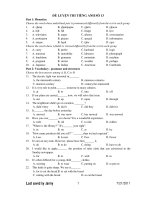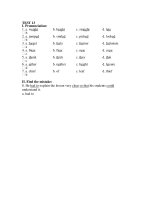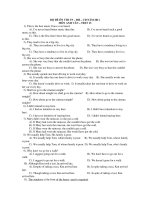Đề thi tiếng anh đề TEST 13
Bạn đang xem bản rút gọn của tài liệu. Xem và tải ngay bản đầy đủ của tài liệu tại đây (121.81 KB, 6 trang )
KỲ THI THPT QUỐC GIA
ĐỀ THỰC HÀNH SỐ 13
I. PHẦN TRẮ C N GHIỆ M: TỪ QUE S T ION 1 ĐẾN QUES T ION 64 ( 8 đ iểm)
Mark the letter A, B, C, or D on your answer sheet to indicate the correct answer to each of the
following questions from 1 to 25.
Question 1: A: “ Do you have a copy of The Last Leaf”?
B: “ You are
luck. I have just one copy left”
A. by
B. in
C. of
D. at
Question 2: Since the flood the number of homeless people
dramatically.
A. are increasing
B. had increased
C. increase
D. has increased
Question 3: Can you make yourself
in French?.
A. understood
B. understand
C. to understand
D. understanding
Question 4: Today many species of plant and animal are in _
of extinction.
A. danger
B. endangered
C. endanger
D. dangerous
Question 5: If the current rate of deforestation continues, the world‟s rainforests
within 100 years.
A. would vanish
B. vanish
C. will vanish
D. would have vanished
Question 6: At first she was trained to be
scriptwriter, but later she worked as
secretary.
A. the / a
B. a / a
C. the / the
D. a / the
Question 7: “ Don‟t look so worried!. You should take the leader‟s comment with
.”
A. a teaspoon of salt
B. a cup of salt
C. a dose of salt
D. a pinch of salt
Question 8: If I
an astronaut traveling in a cabin, I‟d not be annoyed by the weightlessness.
A. am
B. be
C. will be
D. were
Question 9: Our project was successful
its practicality.
A. in terms of
B. with a view to
C. regardless
D. on behalf of
Question 10: Of the two new students, one is friendly and
.
A. the others are not
B. the other is not
C. another is unfriendly
D. other lacks friendliness
Question 11: There is one person to
I owe more than I can say..
A. whom
B. who
C. that
D. whose
Question 12: After a good night‟s sleep I woke up feeling as fresh as
_and eager to start a new day.
A. a fruit
B. a daisy
C. a flower
D. a maiden
Question 13: Mary is sixteen years old. She is
young to get married.
A. too
B. so
C. such
D. enough
Question 14:
is the existence of a large number of different kinds of animals and plants
which make a balanced environment..
A. extinction
B. biodiversity
C. habitat
D. conservation
Question 15: Since we _
to working so hard, can we rest for a while?.
A. don‟t used
B. aren‟t used
C. don‟t use
D. not use
Question 16: - Kate: “ How lovely your cats are!”
- David: “
”
A. Really? They are
B. Thank you, it is nice of you to say so
C. Can you say it again
D. I love them, too
Question 17: Peter was ejected after committing five personal
in water sport game yesterday.
A. mistakes
B. faults
C. fouls
D. errors
Question 18: Toxic chemicals in the air and land have driven many species to the
of extinction.
1
A. tip
B. edge
C. verge
D. border
Question 19: She ran
an interesting article about fashion while she was reading the newspaper.
A. after
B. cross
C. away
D. out
Question 20: It‟s essential that every student
all the lectures.
A. attends
B. attend
C. has attended
D. attended
Question 21: It‟s a secret. You
let anyone know about it.
A. mustn‟t
B. needn‟t
C. mightn‟t
D. may not
Question 22: When Tet holiday comes, Vietnamese people often feel inclined to
their houses.
A. do up
B. do in
C. do through
D. do over
Question 23: - Anne: “ Make yourself at home”
- John: “
”
A. Thanks! Same to you
B. That‟s very kind. Thank you
C. Not at all. Don‟t mention it
D. Yes, Can I help you?
Question 24: He managed to keep his job
the manager had threatened to sack him.
A. therefore
B. although
C. unless
D. despite
Question 25: It was announced that neither the passengers nor the driver
in the crash.
A. are injured
B. was injured
C. were injured
D. have been injured
Mark the letter A, B, C or D on your answer sheet to indicate the word that differs from
pronunciation in each of the following questions from 26 to 27.
Question 26: A. leaves
B. brings
C. looks
D. plays
Question 27: A. watched
B. promoted
C. invited
D. decided
Mark the letter A, B, C, or D to indicate the word that differs from the rest in the position of
the main stress in each of the following questions from 28 to 30.
Question 28: A. require
B. consist
C. achieve
D. system
Question 29: A. intervention
B. necessary
C. intellectual
D. productivity
Question 30: A. intensity
B. accurate
C. erosion
D. miraculous
( ID: 94648 ) Mark the letter A, B, C, or D on your answer sheet to indicate the word or phrase that
is CLOSEST in meaning to the underlined part in each of the following questions from 31 to 32.
Question 31: We went away on holiday last week, but it rained day in day out.
A. every single day
B. every other day
C. every second day
D. every two days
Question 32: We can use either verbal or non – verbal forms of communication.
A. using gesture
B. using speech
C. using verbs
D. using facial expressions
( ID: 94651 ) Mark the letter A, B, C or D on your answer sheet to indicate the word or phrase that
is OPPOSITE in meaning to the underlined part in each of the following questions from 33 to 34.
Question 33: Thousands are going starving because of the failure of this year's harvest.
A. hungry
B. rich
C. poor
D. full
Question 34: There is growing concern about the way man has destroyed the environment.
A. ease
B. attraction
C. consideration
D. speculation
( ID: 94654 ) Mark the letter A, B, C, or D on your answer sheet to show the underlined part that needs
correction from 35 to 39.
Question 35: Men and women in the Peace Corps work with people in the developing countries to help
A
B
them improving their living conditions.
C
D
Question 36: Although not widely sold, that book is considered to be best book on the subject.
A
B
C
D
Question 37: Because his sickness, he didn‟t take part in the English competition held last Sunday.
A
B
C
D
Question 38: I found my new contact lenses strangely at first, but I got used to them in the end.
A
B
C
D
Question 39: Dreaming, like all other mental processes, it is a product of the brain and its activity.
A
B
C
D
Read the following passage and mark the letter A, B, C or D on your answer sheet to indicate the
correct answer to each of the following questions from 34 to 43 .
THE PERFORMING ARTS
In the past, British children were frequently encouraged to try out their performing skills for the benefit
of adults. They did this by reading aloud, acting or
(40)
a musical instrument. As they
(41)
up they were taken to public places of entertainment – the theatre, opera, circus or ballet.
They looked forward to these
(42)
with great
(43)
and would remember and
discuss what they had seen for many weeks afterwards. But nowadays television and computers
(44)
an endless stream of easily
_( 45)
entertainment, and children quickly
accept these marvelous
(46)
as a very ordinary part of their everyday lives. For many
children, the sense of witnessing a very special live performance is gone forever.
But all is not lost. The
(47)
of a TV set may have encouraged a very lazy response from
( 48)
in their own homes, but the
(49)
of those with ambitions to become
performing artists themselves does not seem to have been at all diminished. And live performances in
public are still relatively popular, albeit with an older, more specialist audience.
Question 40: A. handling
B. controlling
C. doing
D. playing
Question 41: A. developed
B. brought
C. advanced
D. grew
Question 42: A. circumstances B. occasions
C. incidents
D. situations
Question 43: A. sensation
B. action
C. thrill
D. excitement
Question 44: A. send
B. supply
C. stock
D. store
Question 45: A. convenient
B. free
C. applicable
D. available
Question 46: A. designs
B. inventions
C. exhibits
D. appearances
Question 47: A. presence
B. attendance
C. company
D. being
Question 48: A. spectators
B. viewers
C. onlookers
D. listeners
Question 49: A. want
B. appeal
C. pressure
D. desire
Read the following passage and mark the letter A, B, C or D on your answer sheet to indicate the
correct answer to each of the following questions from 50 to 59.
Although speech is the most advanced form of communication, there are many ways of
communicating without using speech. Signals, signs, symbols, and gestures may be found in every known
culture. The basic function of signal is to impinge upon the environment in such a way that it
attracts attention, as. For example, the dots and dashes of a telegraph circuit. Coded to refer to
speech, the potential for communication is very great. Less adaptable to the codification of words, signs
also contain meaning in and of themselves. A stop sign or a barber pole conveys meaning quickly and
conveniently. Symbols are more difficult to describe than either signals or signs because of their
intricate relationship with the receiver‟s cultural perceptions. In some cultures, applauding in a
theater provides performers with an auditory symbol of approval. Gestures such as waving and
handshaking also communicate certain cultural messages.
Although signals, signs, symbols, and gestures are very useful, they do have a major disadvantage.
They usually do not allow ideas to be shared without the sender being directly adjacent to the receiver. As
a result, means of communication intended to be used for long distances and extended periods are based
upon speech. Radio, television, and the telephone are only a few.
Question 50: Which of the following would be the best title for the passage?
A. Gestures
B. Signs and signals
C. Speech
D. Communication
Question 51: What does the author say about speech?
A. It is dependent upon the advances made by inventors.
B. It is the most advanced form of communication.
C. It is necessary for communication to occur.
D. It is the only true form of communication.
Question 52: According to the passage, what is a signal?
A. A form of communication that interrupts the environment.
B. The most difficult form of communication to describe
C. A form of communication which may be used across long distances.
D. The form of communication most related to cultural perception.
Question 53: The phrase “ impinge upon” in paragraph 1 is closest in meaning to
A. prohibit
B. intrude
C. vary
D. improve
Question 54: The word “it” in paragraph refers to
.
A. way
B. environment
C. function
D. signal
Question 55: The word “ potential” in paragraph 1 could be replaced by
.
A. advanced
B. possibility
C. organization
D. signal
Question 56: The word “intricate” in paragraph 1 could best be replaced by
A. inefficient
B. complicated
C. historical
D. uncertain
Question 57: Applauding was cited as an example of
.
A. a signal
B. a sign
C. a gesture
D. a symbol
Question 58: Why were the telephone, radio, and television invented?
A. Because people were unable to understand signs, signals, and symbols.
B. Because people wanted to communicate across long distances.
C. Because people believed that signs, signals, and symbols were obsolete.
D. Because people wanted new forms of communication.
Question 59: It may be concluded from this passage that
.
A. only some cultures have signs, signals, and symbols
B. signs, signals, symbols, and gestures are forms of communication
.
C. symbols are very easy to define and interrupt
D. waving and handshaking are not related to culture
Read the following passage and mark the letter A, B, C or D on your answer sheet to indicate the
correct answer to each of the following questions from 60 to 64.
In the mid – nineteenth century, the United States had tremendous natural resources that could be
exploited in order to develop heavy industry. Most of the raw materials that are valuable in the
manufacture of machinery, transportation facilities, and consumer goods lay ready to be worked into
wealth. Iron, coal, and oil – the basic ingredients of industrial growth – were plentiful and needed only the
application of technical expertise, organizational skill, and labor.
One crucial development in this movement toward industrialization was the growth of the
railroads. The railway network expanded rapidly until the railroad map of the United States looked like a
spider‟s web, with the steel filaments connecting all important sources of raw materials, their places of
manufacture, and their centers of distribution. The railroads contributed to the industrial growth not only
by connecting these major centers, but also by themselves consuming enormous amounts of fuel, iron,
and coal.
Many factors influenced emerging modes of production. For example, machine tools, the tools
used to make goods, were steadily improved in the latter part of the nineteenth century – always with an
eye to speedier production and lower unit costs. The products of the factories were rapidly absorbed by
the growing cities that sheltered the workers and the distributors. The increased urban population was
nourished by the increased farm production that, in turn, was made more productive by the use of the new
farm machinery. American agricultural production kept up with the urban demand and still had surpluses
for sale to the industrial centers of Europe.
The labor that ran the factories and built the railways was recruited in part from American farm
areas where people were being displaced by farm machinery, in part from Asia, and in part from Europe.
Europe now began to send tides of immigrants from eastern and southern Europe – most of whom were
originally poor farmers but who settled in American industrial cities. The money to finance this
tremendous expansion of the American economy still came from European financiers for the most part,
but the American were approaching the day when their expansion could be financed in their own “ money
market”.
Question 60: What does the passage mainly discuss?
A. The history of railroads in the United States
B. The major United States industrial centers
C. Factors that affected industrialization in the United States
D. The role of agriculture in the nineteenth century
Question 61: The word “ themselves” in the paragraph 2 refers to
A. sources
B. centers
C. railroads
_
D. places
Question 62: According to the passage, all of the following were true of railroads in the United States in
the nineteenth century EXCEPT that
A. they connected important industrial cities
B. they were necessary to the industrialization process
C. they were expanded in a short time
D. they used relatively small quantities of natural resources
Question 63: Which of the following in NOT true of United States farmers in the nineteenth century?
A. They lost some jobs because of mechanization
B. They were unable to produce sufficient food for urban areas
C. They raised their productivity by using new machinery
D. They sold food to European countries
Question 64: The word “ ran” in the paragraph 4 is closest in meaning to
A. operated
B. hurried
C. constructed
D. owned
II. PHẦN TỰ L UẬN ( 2 đ iểm)
THÍ SINH LÀM PHẦN TỰ LUẬN VÀO TỜ SAU
II. PHẦN TỰ LUẬN:
A. Finish each of the following sentences in such a way that it means exactly the same as the sentence
before it.
Question 1: It's the first time I've been to a flower show.
→ I haven‟t
.
Question 2: “ Be careful! Don‟t do that again,” he said.
→ He warned
.
Question 3: Although the play received good notices, not many people went to see it.
→ Despite
.
Question 4: Without his help we would all have died.
→ If it
.
Question 5: The workers only called off the strike after a new pay offer.
→ Only after
.
B. Write a paragraph about a job you like doing best after graduating upper secondary school.
You should write at least 80 words.
-------------THE END--------------
![Tài liệu [Luyện thi tiếng Anh] REVISION TEST 1 ppt](https://media.store123doc.com/images/document/13/ce/pe/medium_pex1386933310.jpg)








